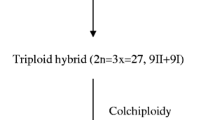Abstract
Chromosome counts were determined for 46 populations ofBiscutella representing 28 taxa. The genus was found to contain diploid taxa with 2n = 12, 16 and 18, tetraploid taxa with 2n = 36 and hexaploid taxa having 2n = 54.B. laevigata L. s. l. consists of diploid and tetraploid populations which are poorly differentiated morphologically. TetraploidB. laevigata s. l. and hexaploidB. variegata Boiss. & Reuter (s. l.) are characterized by chromosomal instability. The variation in chromosome numbers and the occurrence of polyploidy is discussed in relation to the taxonomy of the genus. An investigation of the breeding system showed that most of the annual species were self-compatible and partly inbreeding and most of the perennial species self-incompatible and, therefore, outbreeding, while one annual species,B. cichoriifolia Loisel., showed both systems.
Similar content being viewed by others
References
Baker, H. G., 1959: Reproductive methods as factors in speciation in flowering plants. — Cold Spring Harbor Symp. Quant. Biol.24, 177–191.
Bateman, A. J., 1955a: Self-incompatibility systems in Angiosperms III.Cruciferae. — Heredity9, 53–68.
, 1955b: Note on Dioecy in theCruciferae. — Heredity9, 415.
Beddows, A. R., 1931: Seed-setting and flowering in various grasses. — Welsh Plant Breeding Station Bull.12, Ser. H.
Bresinsky, A., Grau, J., 1970: Zur Chorologie and Systematik vonBiscutella im Bayerischen Alpenvorland. — Ber. Bayer. Bot. Ges.42, 101–108.
Castroviejo, S., 1982: Números cromosomáticos de plantas occidentales, 157–163. — Anal. Jard. Bot. Madrid38 (2), 507–514.
Delay, J., 1971: Orophytes. — Inf. Ann. Caryosyst. Cytogenet. Strasbourg et Lille5, 17–28.
de Wet, J. M. J., 1968: Diploid-tetraploid-haploid cycles and the origin of variability inDichanthium agamospecies. — Evolution22, 394–397.
Dolcher, T., Pignatti, S., 1960: Note Cariologiche su Plante Mediterranee (Biscutella, Convolvulus, Reichardia). — Nuovo Giorn. Bot. Ital.67, n. s., 176–184.
Garde, A., Malheiros-Garde, N., 1953: Contribuição para o estudo cariológico de algumas especies de angiospermicas.I. — Genetica Iberica5 (3–4), 115–124.
Guinea, E., Heywood, V. H., 1964:Biscutella. — InTutin, T. G., & al. (Eds.): Flora Europaea1, 325–330. — Cambridge: University Press.
Hess, H. E., Landolt, E., Hirzel, R., (Eds.), 1970: Flora der Schweiz2, 152. — Zürich: Birkhäuser.
Heywood, V. H., 1960: The taxonomy of polypoids in Flora Europaea. — Feddes Repert.63, 179–192.
, 1964:Biscutella: Taxonomic and Nomenclatural Notes. — Feddes Repert.69, 142–150.
Jackson, R. C., 1962: Interspecific hybridization inHaplopappus and its bearing on chromosome evolution in theBlepharodon section. — Amer. J. Bot.49, 119–132.
Jaretzky, R., 1928: Untersuchungen über Cromosomen und Phylogenie bei einigenCruciferae. — Jahrb. Wiss. Bot.68, 1–45.
Jones, K., 1970: Chromosome changes in plant evolution. — Taxon19, 172–179.
Keck, D. D., 1957: Trends in systematic botany. — Survey of Biological Progress3, 47–107.
Khyos, D. W., 1965: The independent aneuploid origin of two species ofChaenactis (Compositae) from a common ancestor. — Evolution19, 26–43.
Kirchner, O., 1905: Über die Wirkung der Selbstbestäubung bei den Papilionaceen. — Naturw. Z. Land- Forstwirtschaft3, 97.
Küpfer, P., 1968: Nouvelles prospections caryologiques dans la flore orophile des Pyrénées et de la Sierra Nevada. — Bull. Soc. Neuchât. Sc. Nat.91, 87–104.
Larsen, K., Laegaard, S., 1971: Chromosome studies of the Sicilian flora. — Bot. Tidsskr.66, 249–268.
Lawalrée, A., 1955: Flore Générale Belgique Spermatophytes2 (1), 246–250.
Löve, A., 1960: Taxonomy and Chromosomes—a Reiteration. — Feddes Repert.63, 192–202.
Löve, A., Löve, D., 1974: Nomenclatural Adjustments in the Yugoslavian Flora II. Pteridophytes and Dicotyledons. — Preslia46 (2), 123–138.
Machatschki-Laurich, B., 1926: Die Arten der GattungBiscutella L. sect.Thlaspidium (Med.) DC. — Bot. Arch.13, 1–115.
Malinowski, E., 1910: Monographie du genreBiscutella L. I. Classification et distribution géographique. — Bull. Acad. Sci. Cracovie1910, Series B, 111–139.
Manton, I., 1932: Introduction to the general cytology of theCruciferae. — Ann. Bot.46, 509–556.
, 1934: The problem ofBiscutella laevigata L. — Z. Indukt. Abstamm. Vererb.67, 41–57.
, 1937: The problem ofBiscutella laevigata L. II. The evidence from meiosis. — Ann. Bot.1, n. s., 439–462.
Markgraf, F., 1963:Biscutella. — InHegi, G., (Fund.): Illustrierte Flora von Mittel-Europa. Ed. 2.4 (1), 388–394.
Meusel, H., Jäger, E., Weinert, E., 1965: Vergleichende Chorologie der Zentraleuropäischen Flora1. — Jena: G. Fischer.
Ockendon, D. J., 1972: Pollen tube growth and the site of the incompatibility reaction inBrassica oleracea. — New Phytol.71, 519–522.
Olowokudejo, J. D., 1980: Systematic Studies in the GenusBiscutella L. — Ph.D. Thesis, Univ. Reading.
Ornduff, R., 1966: A biosystematic survey of the Goldfield genusLasthenia. — Univ. California Public. Bot.40, 1–92.
Pignatti, S., 1982: Flora d'Italia1, 455–459. — Bologna: Edagricole.
Raven, P. H., Thompson, H. J., 1964: Haploidy and angiosperm evolution. — Amer. Nat.98, 251–252.
Rollins, R. C., 1963a: The evolution and systematics ofLeavenworthia (Cruciferae). — Contr. Gray Herb.192, 1–98.
, 1963b: Protandry in two species ofStrepthanthus (Cruciferae). — Rhodora65, 45–49.
Sampson, D. R., 1964: A one-locus self-incompatibility system inRaphanus raphanistrum. — Can. J. Genet. Cytol.6, 435–445.
Schönfelder, P., 1968: Chromosomenzahlen einiger Arten der GattungBiscutella L. — Österr. Bot. Z.115, 363–371.
Stebbins, G. L., Jr., 1958: The inviability, weakness and sterility of interspecific hybrids. — Advances in Genetics9, 147–215.
Thompson, K. F., 1957: Self-incompatibility in Marrow-stem Kale,Brassica oleraceae var.acephala. I. Demonstration of a sporophytic system. — J. Genet.55, 45–60.
Tobgy, H. A., 1943: A cytological study ofCrepis fuliginosa andC. neglecta and their F1 hybrid and its bearing on the mechanism of phylogenetic reduction in chromosome number. — J. Genet.45, 67–111.
Author information
Authors and Affiliations
Rights and permissions
About this article
Cite this article
Olowokudejo, J.D., Heywood, V.H. Cytotaxonomy and breeding system of the genusBiscutella (Cruciferae). Pl Syst Evol 145, 291–309 (1984). https://doi.org/10.1007/BF00983955
Received:
Issue Date:
DOI: https://doi.org/10.1007/BF00983955




